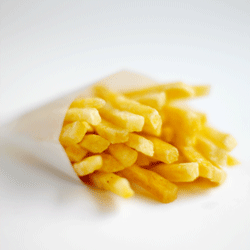Are crisps and chips dangerous for health?

© Thinkstock
The study carried out by the Stockholm University and the Swedish National Food Agency found high levels of a toxic cancerogenic substance, acrylamide, in many products made from starches (crisps, biscuits, chips…). So, by eating such foods, are we poisoning ourselves without knowing it?
A dangerous cooking temperature?
According to the temperature, the cause of this toxicity may be the temperature involved in the cooking. Excessive heating of carbohydrates can cause the formation of the acrylamide enzyme. This concerns all foods containing starch, such as rice, potatoes and foods make from wheat.
The cooking methods that are suspected are deep frying (crisps and of course chips), but also industrial baking ovens in which biscuits are made. When the researchers studied these cereals alone, there was no trace of acrylamide, and it was only after heating, that this substance showed up.
And this, only with certain types of cooking. Boiling these starchy foods provoked no formation of acrylamide, with the scientists finding none in boiled pasta or rice.
A variety of “dangerous” foods…
In their study, the researchers analysed a variety of foods and ready-to-go dishes. They found the highest levels of acrylamide in crisps (up to 1000µg/kg) and chips (up to 500µg/kg). The other guilty foods were: Swedish bread, breakfast cereals, other potato-based product, biscuits, cookies and snacks (such as popcorn). Based on average consumption of these foods, the study authors thus identified the percentage of acrylamide found in each food group:
Potato-based products: 36%
Bread: 16%
Biscuits: 5%
Breakfast cereals: 3%
The remaining 40% would come from the other food groups, not yet studied. In addition, these figures don’t take into account acrylamide found in cigarettes and drinking water. The researchers even cite cosmetics as a potential source of this toxic enzyme.
What are the health dangers of acrylamide?
Acrylamide and its “cousin” polyacrylamide, are well known and are used in industry, notably in plastics. Until now, the principal dangers involved with ingesting these toxins were linked to cigarette smoking and drinking water.
Its toxicity has been widely studied in animals, and it is capable of damaging DNA. We know that prolonged exposure can provoke tumours in rats and mice and that high doses also have neurological effects and reduce fertility. Unfortunately, studies on humans are both few and controversial.
Nevertheless, acrylamide is recognised as a toxic substance by the World Health Organisation (WHO). The European Union recommends not exceeding 0.1 µg/litre in water… but a packet of crisps can contain several hundred times more!
For the Swedish authorities, "The risks associated with acrylamide are not new. We have probably been exposed to acrylamide in food over generations. New data could make it possible to reduce the risks, which we had accepted over a long time without discussion.” They add that further research in this domain is an urgent need.
WHO has announced a meeting with a group of experts on the subject and in the meantime, they recommend eating more fruit and veg, and less food that’s deep fried.
The Swedish National Food Agency
Alain Sousa
More information:
Is alcohol good for you?
'Once-in-a-while' foods
Nutrition discussions


